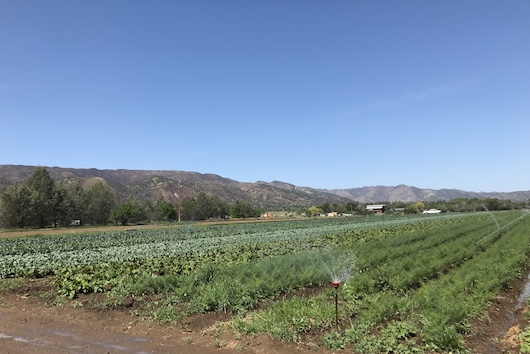You can really tell it’s spring because we’ve already moved on to summer. Not actually – we are very much still in the process of harvesting spring vegetables. But we also are thinking ahead and taking actions now so that we’ll be ready when summer actually gets here. That being said, the weather forecast shows some pretty toasty temperatures next weekend and we’ve already had to do quite a bit of irrigation, much more than would be ideal this early in the year.

Last week we got our first tomatoes of 2021 in the ground! We also transplanted some melons, onions, and some other summer crops. As mentioned in a recent News from the Farm, we direct seed a lot of our crops but there are several things that we put in the field as transplants in order to give them a head start on the weeds and/or on the weather, or because they just do better that way. When it comes time to set them out in the field, there are two ways that it happens: by hand or with a mechanical transplanter.
There are many types of mechanical transplanters, ranging from the very small and simple to larger and fancier ones. See the photo below for a view of the tomato transplanting team as seen from the perspective of the tractor driver. Those three people lift each plant out of its cell in the tray and drop the transplants root first into rotating cups, one per cup. As the rotating part moves further away to the furthest away position, the cup opens and places the plant into the soil. The transplanter opens up a small furrow for the plant before it drops and then packs soil around it after. The other people in the photo are walking behind the tractor to make sure that the plants are going in at the correct depth and to fill in missing plants if plants get stuck in the cups. You can adjust the depth of planting and the distance between plants, up to a point.

*If this is all sounding confusing, there are a plethora of videos on YouTube showing mechanical transplanters at work.
Fun fact about our tomatoes: every couple hundred feet, we plant a member of the Umbelliferae family (dill, cilantro, or fennel) that we let go to flower to provide a habitat for beneficial insects, like syrphid flies and lacewings!
Mechanical transplanting doesn’t work for everything. We can’t use it for crops that need to be placed quite close together, or those that are more delicate or have an odd shape that will get stuck in the machine. For these, we transplant by hand. A few people lay out the transplants in the row with the correct spacing and then others come and quickly tuck them in before they dry out, making sure that the soil surrounding the roots is no longer visible. We transplant our onions this way and all of our flowers. It’s tedious work!

The work required to hand transplant makes me reflect on the true cost of our food and flowers. We think of onions as the staple of many of our dishes, and therefore expect them to be cheap. Produce can only be cheap if it’s easy and fast to grow and doesn’t require much labor. Onions actually grow pretty slowly (the ones in your box this week have been in the ground since mid-November!) and for most farms, including ours, they require a fair amount of labor to plant, maintain, and harvest. A diversified farms like ours can’t invest in too much specialized labor-saving equipment just to simplify growing one crop, unlike a farm that specializes just in onions or in a small number of crops. Just something to think about the next time you see an onion!
— Elaine Swiedler, CSA Manager
